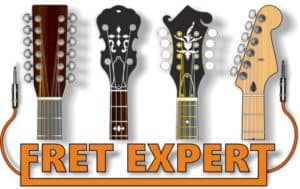Any discussion of the banjo or how to play banjo chords will most likely be referring to the best known of this family of instruments, the 5-string, ‘G’ or bluegrass banjo.
This instrument is instantly recognizable by its uniquely placed fifth string tuning peg half-way up the fingerboard.
In this article, I’m going to concentrate on two of the most popular tunings for the 5-string banjo:
- Open G – as close to standard tuning as you’ll get with the banjo and
- Standard C – the predecessor to Open G.
There are many other popular and niche tunings for the instrument, but for a beginner, it’s sensible to concentrate on two of the most versatile and widely used tuning configurations.
Covered in this Article:
Understanding the Chordboxes in this Article
Before you begin, study the chordbox diagrams below to understand how they work. If you already play a fretted instrument you’ll know exactly how to read them and can move onto the next section.
Simple Chord Diagrams
First of all, you’ll need to familiarise yourself with the chordbox (or chord window) diagrams:
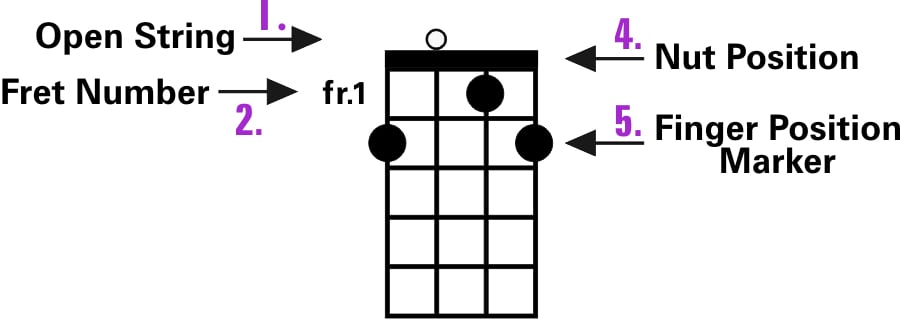
Above is a simplified diagram you might find in a songbook, rather than in a chord dictionary or encyclopedia.
This will omit any individual note names and intervals and will generally expect you to figure out which finger to use.
With a little practice, you will find that your fingers will automatically fall into the correct positions without the need for fingering numbers on every chordbox diagram.
Detailed Chord Diagrams
The four diagrams below contain all of the constituent parts you’ll most likely see in a songbook or more detailed chord dictionary:
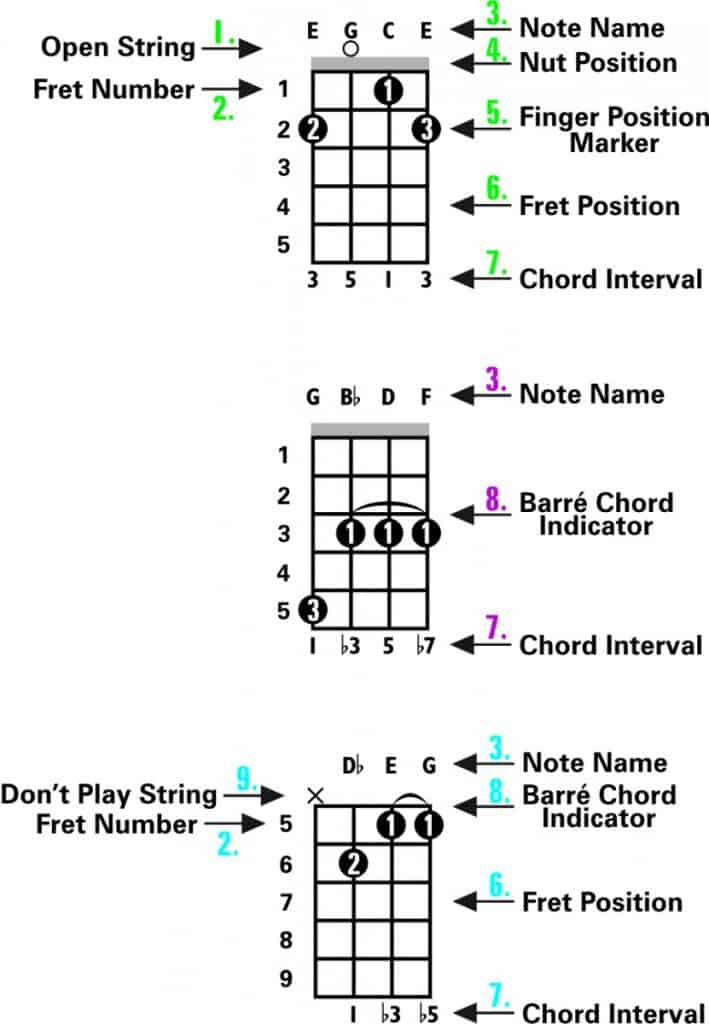
Viewing the chordbox is like standing your instrument on the floor in a vertical position and reading the strings from left to right in the following order: 5th string, 4th string, 3rd string, 2nd string, and 1st string.
The 4th string will be your lowest sounding string and will be nearest to your chin in the standard playing position, other than the 5th string and tuner, which is opposite the 5th fret.
The numbers on the diagrams above are:
1. Open String
An open white circle indicates a string to be played, but NOT fretted.
2. Fret Number
The vertical column of numbers indicates the position on the fingerboard.
3. Note Name
The name of the individual note being played as part of the chord.
4. Nut position
The nut is the white bar where the headstock joins the neck and fingerboard. In most chordboxes this will be displayed in gray or black.
When this is present it indicates the chord will be played within the confines of the first five frets. If this is missing, the chord will further up the fingerboard.
5. Finger Position Marker
This shows you where to place your finger/s on the fingerboard and which fingers to use.
6. Fret Position
The grid boxes indicate a fret position on the fingerboard.
7. Chord Intervals
Intervals are the musical distances or relationships between the different notes in a chord.
In the first diagram (green numbers), the chord is C Major. It contains a 1st (commonly called the root note), a 3rd (called a major third) and a 5th (referred to as a perfect fifth).
In the second diagram (purple numbers), the chord is Gm7 (G minor seventh). This chord contains the root note (a first), a minor or flatted third, a fifth (perfect fifth) and a minor or flatted seventh.
In the third diagram (turquoise numbers), the chord is ‘Dbdim’ (diminished), and it contains the root (a first), a minor or flatted third and a diminished fifth.
8. Barré Chord Indicator
This is a chord to be played by a finger or fingers covering more than one string using the same finger.
The official pronunciation comes from the French (‘bar-ray’), but has been anglicized to ‘bar’. The accent over the ‘e’ is generally missing in American English. The barré is indicated by a horizontal bracket covering the strings to be played with a particular finger.
9. ‘Don’t Play’ String
An ‘x’ above a string indicates that it shouldn’t be played.
If the x is on the fingerboard, the string should be muted or damped by lightly placing the pad of a finger on top of the string without pressing it down onto the fingerboard. This can take a little practice to get the correct pressure.
I will cover some of the interesting aspects of the instrument in greater detail later, but for now, let’s get down to the nitty-gritty of playing your first banjo chords!
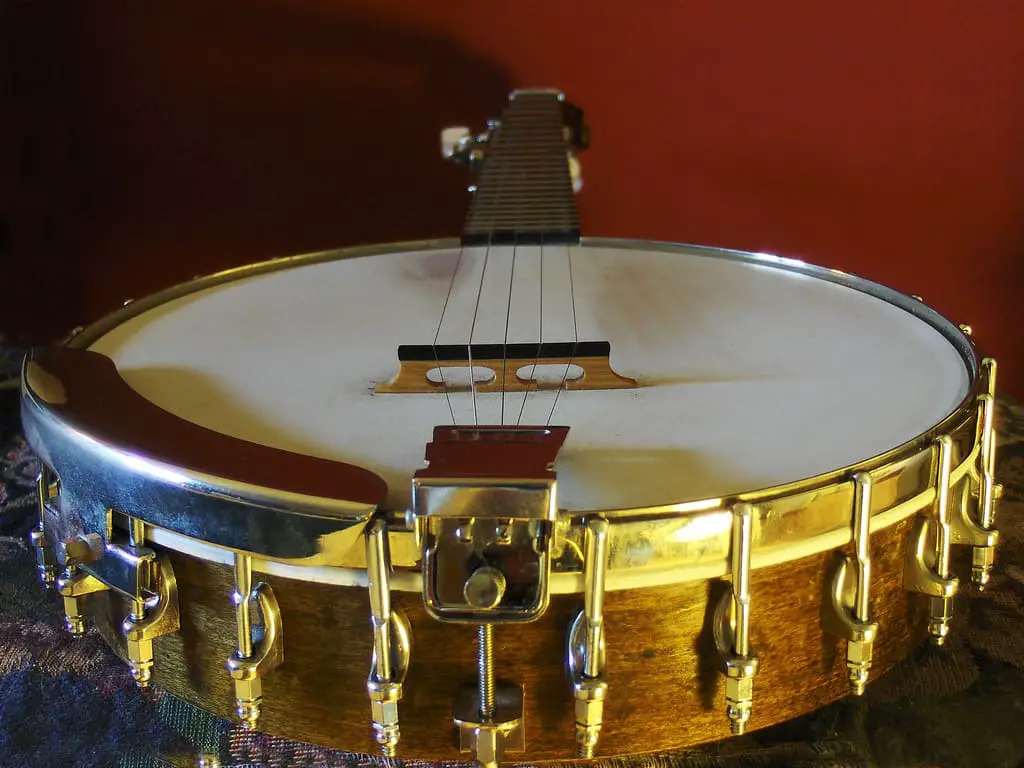
Basic 5-String Banjo Chords For Beginners
Let’s start with a selection of chords aimed at the total beginner. In this instance, I’ll be assuming you come from a knowledge base of zero and this is the first fretted instrument you’ve ever picked up in your life.
I’ve rated the difficulty of the chords by a series of green dots:
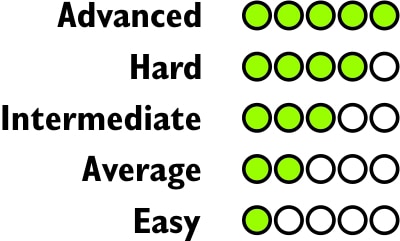
The chords you should be concentrating on at first are rated as ‘Easy’ (1 green dot).
As you get more confident you can try graduating from one to two and three dot chords.
I’ve only included a few simple two-note barré chords in the two tunings, so that you aren’t faced with too high a degree of difficulty at first.
As with learning anything new, it’s better to start slowly and work up, rather than to feel discouraged if you can’t reach a level beyond your current skill set.
The two limited selections of chords featured below are for Open G tuning (the first set) and Standard C tuning (the second set):
Open G Tuning Chords for the 5 String Banjo
A selection of Open G Chords are shown below, with the difficulty ratings in green dots:
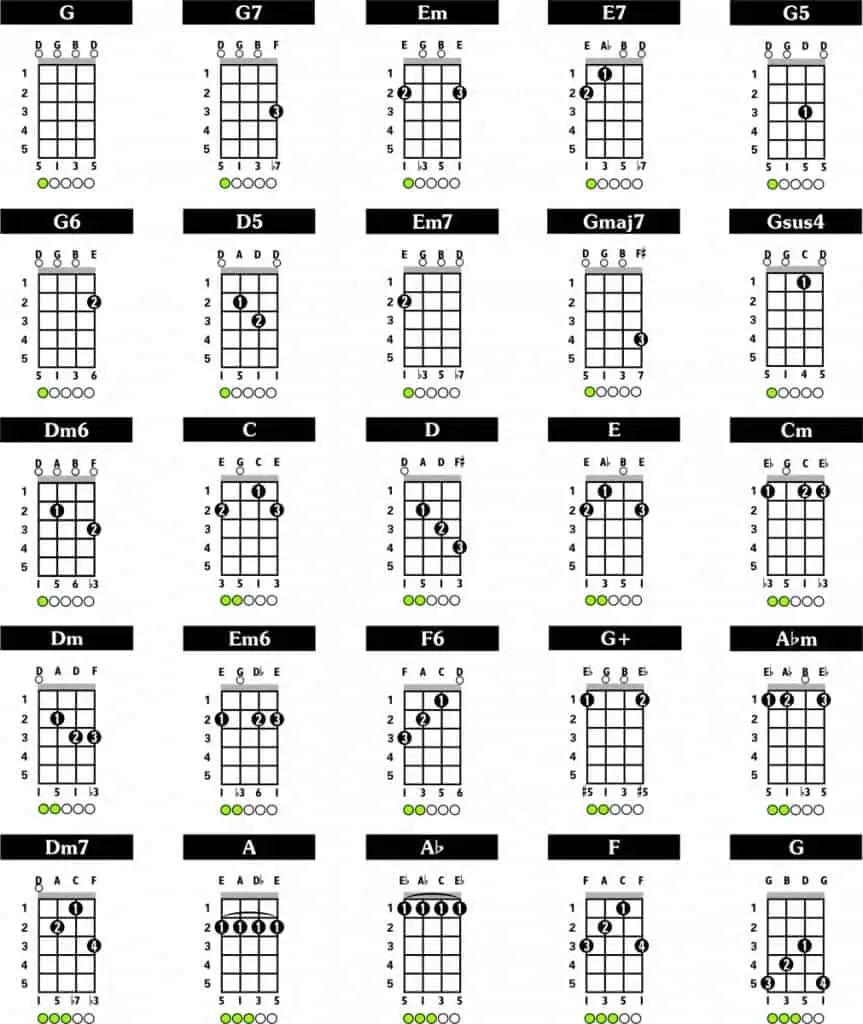
The term ‘Open G’ refers to all the strings being tuned to the constituent parts of a G Major chord (i.e. G, B and D).
You may be wondering – how does that works when you have only three notes in a G Major chord (G, B and D) and five strings on a banjo?
Thankfully, the answer is very straightforward; two of the string tunings are repeated, giving you ‘ gDGBD’ (two G’s, two D’s and one B string).
Standard C Tuning Chords for the 5 String Banjo
Here’s a selection of C Tuning Chords, again, with difficulty ratings illustrated by the green dots:
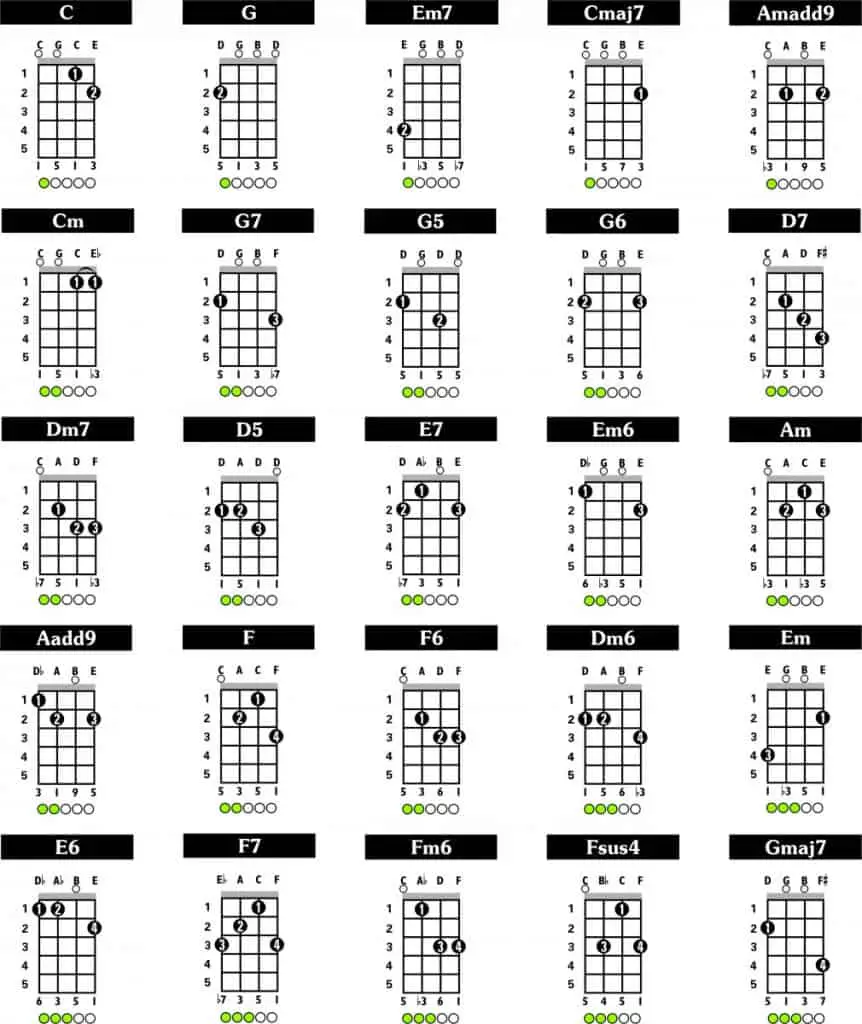
‘Standard C’ as a term is a little misleading as it doesn’t truly represent a C Major chord as you might imagine it would.
Instead, it’s technically a G Major chord with an additional ‘C’ note thrown in for good measure!
If you were writing it as a guitar or piano chord, it would probably be expressed as G/C (or a G Major with an additional ‘C’ bass note).
Why The Chordboxes Don’t Include All Five Strings
The fifth string is considered a drone string and doesn’t normally feature in typical banjo chord structures, unless you play much further up the neck.
Some banjo players do use a 5-string capo, which is bolted onto the neck to accommodate different keys.
For instance, if you were using a regular capo to play in the key of ‘A’ (2nd fret) for example, you would probably need to either retune the 5-string up a whole note to ‘A’ or use a 5-string capo, by sliding it up to the seventh fret.
A much simpler method is often used by players who don’t want this cumbersome contraption screwed onto their banjo neck – they tap little model railroad/railway spikes into the fingerboard and hook the fifth string around them. Simple, but effective!
How to Play 5 String Banjo Chords
One thing common to most fretted instrument beginners is a tendency to get fret buzz, especially if you’re using several fingers to form a particular chord shape.
My advice is not to lay your fingers in too flat a position on the fingerboard (with the exception of barré chords). Keep them nicely arched and this should avoid the dreaded buzz!
You may also find you’re accidentally touching another string with one of your fingers, creating a buzzing or a muting effect.
Try to separate your fretting fingers as much as possible to avoid this occurring. You can tell if this is happening by plucking each note in the chord individually and seeing if they ring out properly.
Don’t practice for too long at first until you’ve developed calluses on your fretting fingers or you may well end up with blisters!
There is a way to obviate this and that’s by investing in a set of silicon fingertip protectors or a pair of guitar gloves, that will also work well when playing the 5 string banjo.
These will allow you to practice for a lot longer. The downside is that they will slow down the development of calluses. It’s very much your decision.
The 5-string banjo is typically played using very specific fingerpicking techniques based around corresponding chord shapes. One particularly famous exponent of 5-string banjo picking was the bluegrass recording artist, Earl Scruggs, who developed the much-copied ‘Scruggs Style’.
The 5-string can also be strummed in certain situations as well as picked.
What Are Moveable 5-String Banjo Chords?
Moveable chords are chord shapes that use a specific fingering position. This can be slid up and down the fingerboard to change into a different key without altering the shape of your fingers.
This is mostly applicable to 4-finger or barré chords. See some examples below:
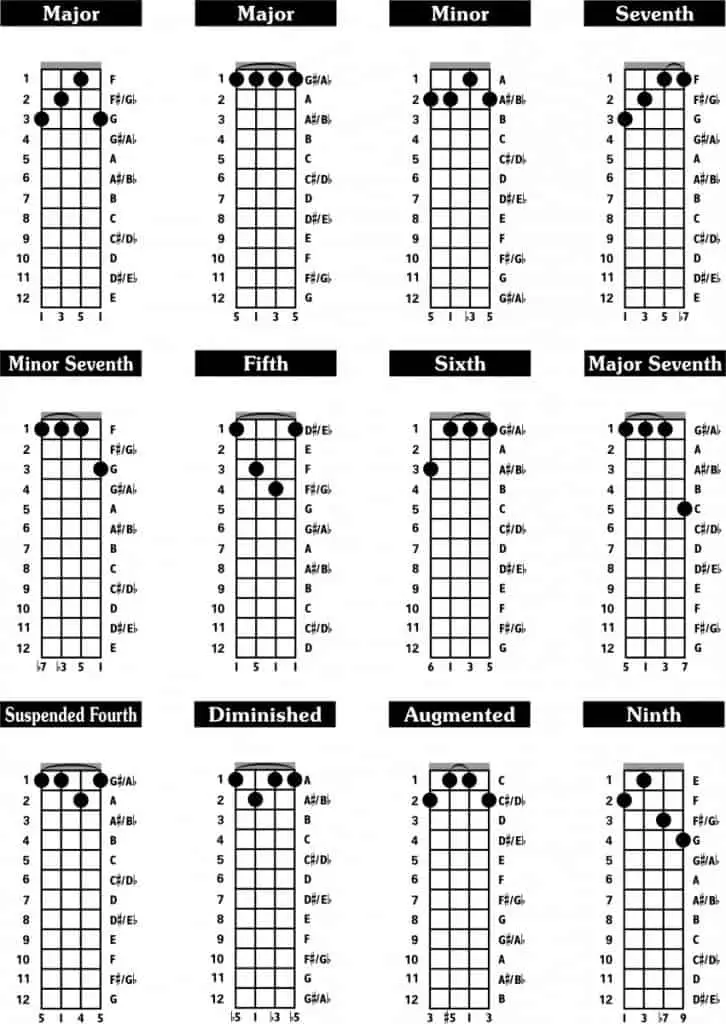
To read these moveable chords, you’ll see the chord shape at the very top of the fingerboard diagram. This will be the first position you can play for that particular chord shape.
Taking the first example of a ‘Major’ chord, you’ll see the note name of ‘F’ at the very top of a column of twelve notes. This means the first chord you can play using this fingering arrangement is the chord of ‘F Major’.
Now if you slide that same finger shape up 1 fret you’ll be playing the chord of ‘F# Major’, then ‘G Major’ and so on.
Using this useful technique you can discover many different chords in all twelve keys. Always bear in mind that a ‘Major’ shape will always be a ‘Major’ shape, regardless of how high up the fingerboard you are.
Ditto, a ‘Seventh’ will always be ‘Seventh’ etc., it’ll just be in a different key. The moveable fingerboard chordboxes also include the musical intervals underneath each string.
Again, a Flatted Third will always be a Flatted Third and a Major Sixth will always be a Major Sixth, no matter where you are on the fingerboard, it’s just the key that changes.
Advice for Left-Handed Players on a 5 String Banjo
If you’re planning on taking up the banjo, it’s imperative that you buy a left-handed model, as it’s impossible to just flip the strings and re-groove the nut, due to the fifth string tuning peg being situated where it is.
If anyone tries to persuade you otherwise, it’s like trying to write with your wrong hand – it will make learning doubly difficult!
For the lefties among us, don’t be discouraged, but you will probably need to make up your own chord charts. This is actually very easy, but a little time consuming if you want a comprehensive set of chords. So what do you do?
Firstly, either print out your own blank chordbox charts or buy a ready-made book of blank chordboxes. Then just reverse the examples in this or any other banjo chord book or online source. Like this:
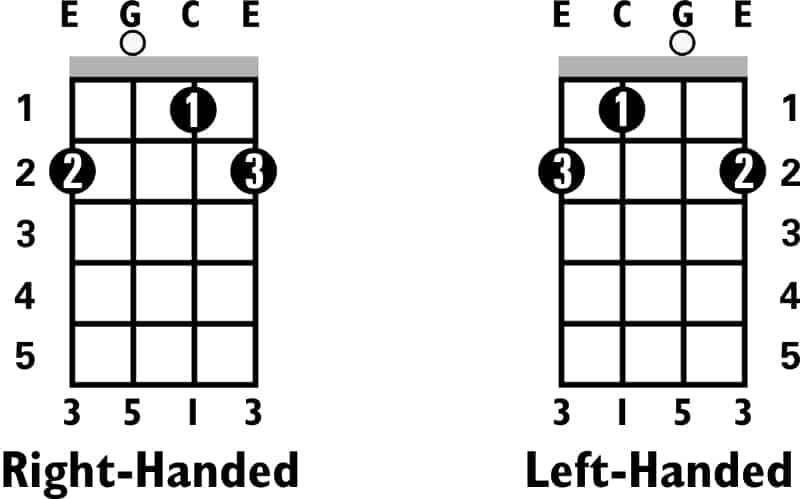
What Are 5 String Banjo Chord Inversions?
An inversion of a chord is where the notes remain the same, but run in a different order higher up or lower down the fingerboard.
Here we have the example of ‘C Major’ (Open G tuning). The chord of ‘C Major’ always contains the notes C, E, and G:
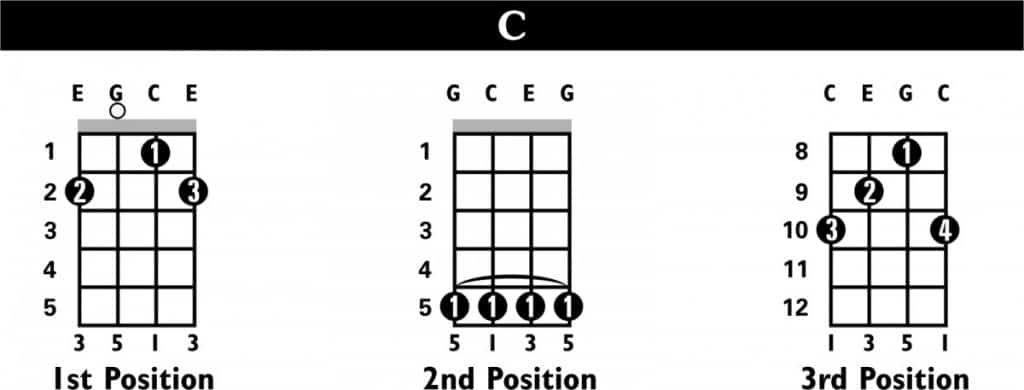
If you look at the notes above the chordboxes, you’ll see EGCE is the order in the 1st position on the first fret, followed by GCEG on the fifth fret and lastly CEGC on the eighth fret.
It’s the same three basic notes, but in a different order. Inverted chords occur on every fretted or keyboard instrument you would care to mention.
Tuning Chords on a Plectrum Banjo vs the 5 String
The good news for Plectrum Banjo players is that Standard C tuning is also employed on the plectrum banjo.
The only difference is that the plectrum doesn’t feature the 5th string drone and, as the name suggests, tends to be played with a pick or plectrum.
‘Fretted Friends’ Banjo Chord Books
If you liked this article and want to advance your knowledge of 5 string banjo chords, I’ve written two books that will be a big help to your 5-string banjo playing. You’ll get:
- Many chords in all 12 keys
- 68 different chord types in each key
- Slash chords
- Moveable chord shapes
- Fingerboard and tuning layouts
- Banjo family fact files and tunings
- Chord theory and FAQs
- Chordbox blanks for your own arrangements
The first is the Bluegrass Banjo Chord Bible, which has 2,160 Chords in Open G Tuning. Click here to view the current price on Amazon. You can preview it there, too.

The Plectrum Banjo Chord Bible has 1,728 Chords in Standard C Tuning. You can also view it (and preview it) on Amazon by clicking here.

Finally, there’s also my 4-String Chordbox Blanks Workbook, which has 3,888 Blank 4-String Chordboxes for your musical ideas. You can also take a look at it on Amazon, and also preview it, too.

If you play other fretted instruments, you can view the whole catalogue of my book series here, too. Happy playing!
